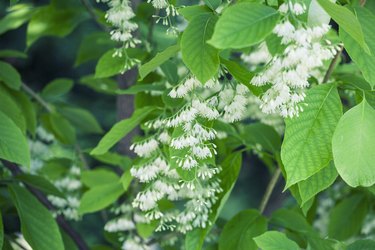
All trees produce seeds, but their methods of protecting them vary widely. While some trees produce fruits and cones, you'll see other trees with large seed pods. Seed pods come in a range of sizes, shapes and textures, including those with furry coatings. Many seed pods attract wildlife and serve as an important food source for birds and ground mammals. If you want to plant fuzzy seed pod-producing trees in your landscape, choose species with cultural requirements compatible to the conditions in your planting site.
Non-Native Deciduous Trees
Video of the Day
Non-native trees were introduced to North America after European settlement. The white poplar (Populus alba, USDA zones 3-8) produces 1/2-inch-long seed pods covered with fuzz. This deciduous tree, which is on the noxious weed list in many locations and is best not considered as a new landscape specimen, grows up to 100 feet tall with a 50-foot spread. It has lobed, dark-green foliage with white, fuzzy undersides. White poplars grow well in full sun and a range of soils, from wet to dry.
Video of the Day
The fragrant epaulette tree (Pterostyrax hispidus, zones 5-8) produces gray, furry seed pods that last through winter. This deciduous tree grows to 30 feet tall with long, silvery-green leaves that turn yellow in autumn. It prefers full sun and moist, well-drained soil.
Native Deciduous Tree With Long Seed Pods
Deciduous trees lose their foliage in winter. The American sycamore (Platanus occidentalis, zones 4-9) produces furry, round, pendulous seed pods in winter. This deciduous North American native prefers sun to partial shade and moist, well-drained soil. It grows quickly to 100 feet tall with an 80-foot spread and has a thick trunk covered with white, exfoliating bark.
The native or velvet mesquite (Prosopis velutina, zones 9-11) produces hairy, brown, edible seed pods. This deciduous tree is native to the southwestern U.S. and Central America. It grows to 30 feet tall with an equal spread and prefers full sun and deep soil. Velvet mesquite produces yellow and white flowers in early summer and has irregular, twisted branches and fuzzy, compound gray-green foliage.
Shade-Tolerant Native Evergreens
Evergreens keep their foliage year-round. Many prefer full sun but some tolerate a few hours of shade each day. The mountain ironwood (Cercocarpus betuloides, zones 5-9) produces hairy, brown seed pods. This native evergreen tree grows to 20 feet tall. It thrives in full sun to partial shade and moist to dry soil. This drought-tolerant tree has gray-green foliage and blooms with red, white and green flowers in spring.
The Jamaican caper (Capparis cynophallophora, zones 10-11) is another tree with a long seed pod. It produces fuzzy, 2- to 7-inch-long brown seed pods. This evergreen tree grows from 10 to 20 feet tall and has aromatic bark. Jamaican capers have glossy, evergreen foliage and bloom with showy white and purple flowers year-round. Native to Florida and the Caribbean, Jamaican capers grow well in partial shade or full sun and tolerate drought.
Sun-Loving Native Evergreens
Native evergreens for full-sun exposures include the Texas mountain laurel (Sophora secundiflora, zones 7-10), which produces 3- to 4-inch-trees with large seed pods. The seed pods are fuzzy and brown in color. These pods contain toxic orange seeds. Texas mountain laurels grow to 20 feet tall with a 10-foot spread and have gray-green foliage. They tolerate drought and prefer full sun and well-drained, alkaline soil.
The New Mexico or rose locust (Robinia neomexicana, zones 5-8) produces fuzzy, dark brown seed pods. It grows to 15 feet in a shrublike form, has dense, thorny foliage and blooms with clusters of pink blossoms in spring. This drought-tolerant tree prefers full sun and tolerates a range of soils.
- North Carolina State University Cooperative Extension: Sophora secundiflora
- North Carolina State University Cooperative Extension: Platanus occidentalis
- North Carolina State University Cooperative Extension: Pterostyrax hispidus
- Missouri Botanical Garden: Populus alba
- University of Florida IFAS Extension: Capparis Cynophallophora Jamaican Caper
- Urban Forest Ecosystems Institute at Cal Poly: Mountain Ironwood
- Urban Forest Ecosystems Institute at Cal Poly: Velvet Mesquite